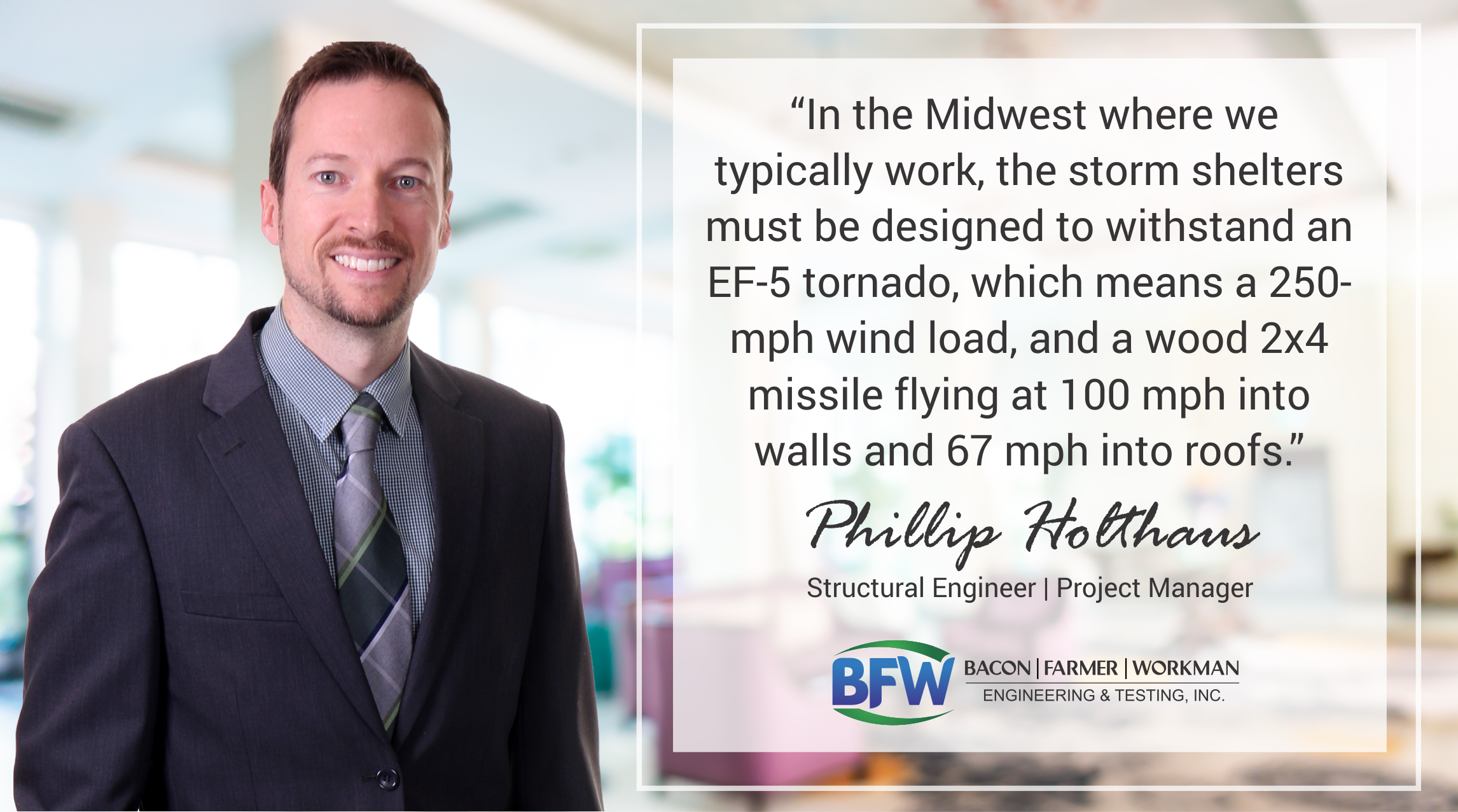In January 2019 the state of Kentucky passed a law that any public or private school with a capacity of 50 or more would require a storm shelter that meets ICC-500 standards. To put it simply, you can’t just slap up some walls and a roof and call it a day; you have to actually prove your shelter is effective even during a severe (EF-5) tornado.
New Requirements Mean More Shelters
We sat down with Phillip Holthaus, Structural Engineer/Project Manager, to get some insight into the storm shelter requirements; what we were doing, what we are doing, and what we’ll be doing in the near future with community storm shelters.
“We’ve designed dozens of storm shelters already and many more are in the queue. These storm shelters have been a component of a variety of projects; emergency services buildings, additions to existing schools, portions of brand-new schools, server rooms of corporate headquarters, and break rooms of office buildings.
Our region has required storm shelter protection for emergency services buildings for a while, but the requirements for storm shelters in schools have been more recent. In most of the states that we regularly operate in, storm shelters are now required for new schools and renovations of existing schools. The ICC-500 code governs the design of these storm shelters. This code requires peer reviews for most storm shelters, so BFW/Marcum has designed shelters, but has also provided peer review services for storm shelters designed by other teams.”
It’s All About the Materials
As a structural engineer, it’s Phillip’s job to understand the variety of materials available for building a shelter, as well as how they perform during an extreme weather event.
“In the Midwest where we typically work, the storm shelters must be designed to withstand an EF-5 tornado, which means a 250-mph wind load, and a wood 2×4 missile flying at 100 mph into walls and 67 mph into roofs.

We also need to make sure that the host building (structure around the storm shelter) can be partially or even completely demolished by the tornado without compromising the integrity of the storm shelter.”
To put it another way; Phillip needs to ensure if a school is completely demolished by a tornado, the debris from that school will not penetrate or collapse the adjacent shelter.
We Look at All Angles
“Since we must design for the host building to collapse around the storm shelter the location can be critical structurally. If the shelter is in a basement, it helps reduce wind loads on the shelter because the walls are underground, but the host building above can collapse on top of the structure or can be ripped away so that becomes challenging to account for in the design stage. We have to consider every angle.”
We asked Phillip if it was common to “retrofit” a shelter using an existing structure.
“It would likely not be feasible to turn an existing structure into a storm shelter, so if a storm shelter is needed for an existing building, it would likely need to be provided as an addition.
For new facilities needing storm shelter, there are a few factors that need to be considered when choosing the protected space. It first needs to have the necessary square footage to support the number of occupants required. It also needs to have the proper ingress and egress. We often see larger and taller spaces like gymnasiums as the shelter or the breakroom of a building.”
With Higher Storm Shelter Standards Come Safer Schools
While many tornadoes can form, run their course, and never touch a man-made structure, there is always the chance that one (or more) will hit a town or city. It’s unfortunate but true.
Phillip chimes in on this, “To be honest, the prevalence of tornadoes year-to-year is a moot point. The chances are always present. However, the severity of the impact really seems to come down to the location and path of the tornado and if it happens to line up with populated cities.
What I am noticing is when the unfortunate event happens that larger towns take direct hits or we have many injuries or deaths, it seems to push states to encourage or require more protection. Reactionary responses show that we are making progress in improving our storm safety; however, the engineering professionals and the governments need to continue to strive to be proactive and forward thinking when it comes to the safety of our loved ones and ourselves.”
There’s a Bright Spot in Every Dark Cloud
“The days of crouching in the hallway with a book over your head will soon be over,” Phillip explains. “Many states are beginning to appreciate the need for better protection as well as more sophisticated weather warning systems, which gives us more warning time than in the past.”
We’re happy to do our part in weathering the storm, especially when it comes to the children in our schools. As standards increase, so does our responsibility as an engineering firm. We will continue to meet and exceed those standards for the benefit of all.

Recent Comments